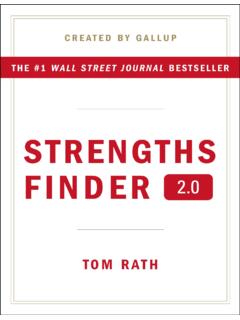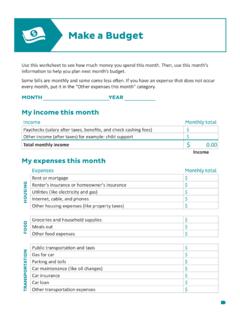Transcription of Education Technology Use in Schools
1 Education Technology Use in Schools Student and Educator Perspectives COPYRIGHT STANDARDSThis document contains proprietary research, copyrighted and trademarked materials of gallup , Inc. Accordingly, international and domestic laws and penalties guaranteeing patent, copyright, trademark and trade secret protection safeguard the ideas, concepts and recommendations related within this document. The materials contained in this document and/or the document itself may be downloaded and/or copied provided that all copies retain the copyright, trademark and any other proprietary notices contained on the materials and/or document.
2 No changes may be made to this document without the express written permission of gallup , Inc. Any reference whatsoever to this document, in whole or in part, on any web page must provide a link back to the original document in its entirety. Except as expressly provided herein, the transmission of this material shall not be construed to grant a license of any type under any patents, copyright or trademarks owned or controlled by gallup , Inc. gallup is a trademark of gallup , Inc. All other trademarks and copyrights are property of their respective 2019 gallup , Inc. All rights Technology Use in SchoolsTable of Contents04 Introduction06 Key Findings09 Section 1: Access and Availability In and Out of School17 Section 2: Criteria for Selecting and Purchasing27 Section 3: Value and Utility43 Section 4: Perceptions of Effectiveness 53 Section 5: Approaches to School and Learning59 Conclusion59 Methodology60 About gallup and NewSchools Venture FundCopyright 2019 gallup , Inc.
3 All rights Technology Use in SchoolsCopyright 2019 gallup , Inc. All rights Technology Use in SchoolsThe goal of this report is to better understand student and educator perceptions and usage of Education Technology in 2019 gallup , Inc. All rights Technology Use in SchoolsIntroductionIntroductionThe Education Technology Use in Schools report reflects the views of students, teachers, principals and district administrators on digital learning tools. Including the perspectives of those most familiar with the impact of these tools in Schools can lend important clarity for those seeking to develop new and innovative ways to help teachers teach and help students learn.
4 Results of the surveys are from a sample of 3,210 Pre-K through 12th grade public school teachers, 1,163 public school principals, 1,219 district level administrators, and 2,696 public school students in 3rd through 12th grade. NewSchools Venture Fund and gallup collaborated to develop the surveys. gallup consultants conducted focus group interviews with students and educators to inform questionnaire development. Rigorous survey methods were used with the aim of securing results that are representative of students and educators in public Schools . Please see the methodology for more information on the study approach.
5 The study is designed to build understanding of five topics:01current access to and availability of Education technology02criteria for selecting and purchasing digital learning tools03perceptions of the value and utility of digital learning tools04perceptions of the effectiveness of digital learning tools05extent to which Schools employ certain approaches to teaching and learningThe report reflects the results from surveys of students, teachers, principals, and district administrators. The results provide critical information for educators, leaders, developers and entrepreneurs to maximize the effectiveness of digital learning tools that support teaching and learning today.
6 The working definition of digital learning tools used for this study is intentionally broad, allowing respondents to consider ways that Education is enhanced and impacted by digital learning tools. Digital learning tools are websites, apps, online tutorials, online games and videos or programs used to teach and support student learning and schoolwork. Copyright 2019 gallup , Inc. All rights 2019 gallup , Inc. All rights Technology Use in SchoolsIntroductionIn this report, digital learning tools are defined as websites, apps, online tutorials, online games and videos or programs used to teach and support student learning and 2019 gallup , Inc.
7 All rights Technology Use in SchoolsKey FindingsKey FindingsAccess and Availability In and Out of SchoolDigital learning tools are integral to teaching and learning in and out of school. About two-thirds of teachers (65%) say they use digital learning tools to teach every day; 22% use them a few days a week, and 13% use them once or less per week. More than half of teachers (53%) report that their students use digital learning tools every day to learn. About seven in 10 students report using digital learning tools outside of school for schoolwork at least a few days a week. Many teachers would like to use digital learning tools more often to half of all teachers surveyed (53%) say they would like to use digital learning tools to teach more often; 44% would like to use them about as often as they use them now.
8 About six in 10 teachers who use digital learning tools a few days per week or less say they would like to use them more often to teach. About four in 10 of students would like to use digital learning tools to learn more teachers (64%), principals (73%) and administrators (66%) than students (42%) themselves say students would like to use digital learning tools more often to for Selecting and Purchasing Educators select digital learning tools that support student learning and meet learning 15 possible selection criteria, teachers are most likely to say that immediate and actionable data on students progress (35%), allows for personalized instruction based on students skill levels (35%)
9 , engaging students with school and learning (30%) and easy to use (30%) are the most important factors for selecting digital learning tools for use in their classroom. Majorities of teachers, principals and administrators say digital learning tools support content that aligns with state standards or district rated criteria, teachers, principals and administrators are most positive about the extent to which digital learning tools support content that aligns with state standards or district initiatives. Majorities of each group (53%, 51% and 51%, respectively) say they do this a great deal.
10 Copyright 2019 gallup , Inc. All rights Technology Use in SchoolsKey FindingsTeachers, principals and administrators say there is some but not a lot of information about the effectiveness of digital learning tools. Most teachers (84%) say they are able to choose some of their own digital learning tools for use in their class(es), though 27% say there is a lot of information available about the effectiveness of the tools they currently use. Similarly, 25% of principals and 18% of administrators say there is a lot of information available about the effectiveness of the digital learning tools they use.






